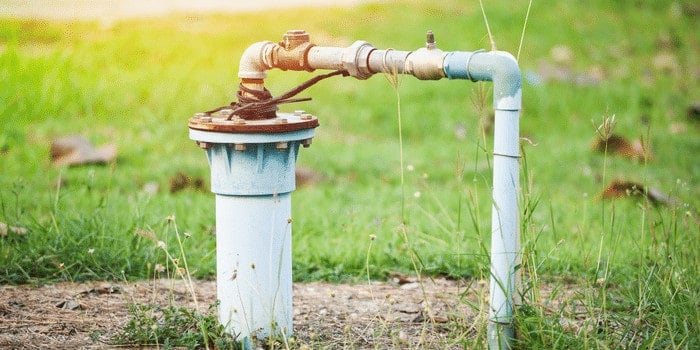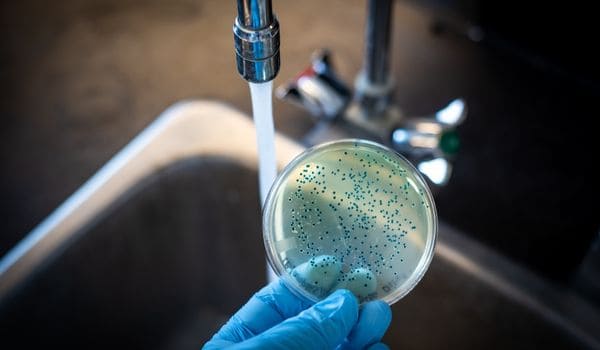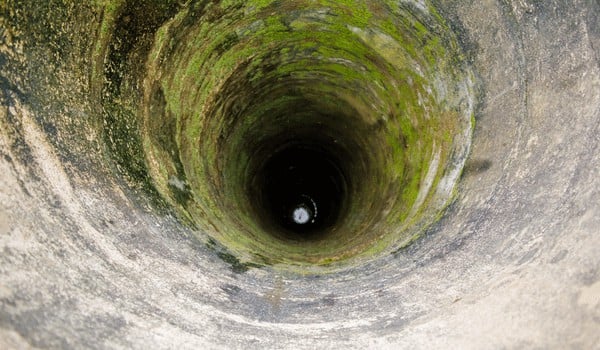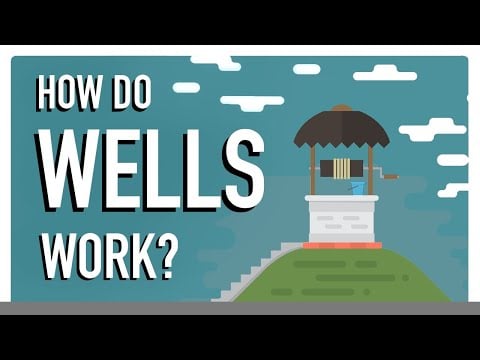More than 40 million Americans rely on private wells — but many homeowners don’t really know how their system works until something goes wrong.
And while today’s wells are a far cry from the old hand-pumped versions, they still require care and maintenance to keep water flowing clean and safe.
Whether you’re new to wells or just curious about what’s going on underground, here’s a clear, no-fluff breakdown of what makes your well tick — from aquifers and pumps to pressure tanks and filtration.
⚡ Quick Takeaway
- 🚰 Wells tap into underground water stored in aquifers
- 🔧 A pump moves water into a pressure tank — which sends it through your home
- 🛠️ Regular inspections and annual testing keep things running clean and safe
- 💦 Contaminants can sneak in through cracks, runoff, or faulty parts — testing helps catch them early
- 🏡 Most problems are preventable with routine maintenance and the right equipment
⚙️ How a Well Works
Wells tap into underground aquifers — natural reservoirs made of water-bearing rock and soil. These aquifers are refilled over time by rain and melting snow that seep into the ground.
To access this water, a well is drilled deep into the earth and fitted with a well pump that pulls water up into your home. That water then flows into a pressure tank, which stores and pressurizes it for use at your taps, showers, and appliances.
Most private wells rely on three key components:
- 🛠️ The well – the shaft drilled into the ground to access groundwater
- 🔌 The pump – draws water up from the aquifer
- 🚿 The pressure tank – holds water and keeps it flowing with consistent pressure
📌 Without a pressure tank, you’d barely get a trickle on the second floor. These systems make your well water feel just like city water — but with a little more self-reliance.
🛠️ Types of Wells

Not all wells are created equal. The type of well you have depends on your region’s geology, how deep the groundwater sits, and how the well was installed.
Here’s a quick look at the most common residential well types:
| Well Type | How It Works |
|---|---|
| 🔩 Drilled Well | Bored deep into bedrock with heavy machinery — often hundreds of feet down. Strong, long-lasting, and less prone to contamination. |
| 🪣 Dug Well | Shallow and hand-dug or bored — typically 30 ft or less. Common in older homes but more vulnerable to runoff and surface contamination. |
| 🔧 Driven Well | Made by driving a narrow pipe into the ground. Deeper than dug wells but shallower than drilled wells. A budget-friendly middle ground. |
💡 Each type of well has its pros and cons — deeper wells tend to be safer, but they’re also pricier to install. Shallow wells may be easier to maintain but require more frequent testing.
⚙️ Well Pump Options

Your well can’t do its job without a pump — it’s the system’s muscle, pulling water from underground and delivering it to your home.
Here are the two most common pump types you’ll find:
| Pump Type | How It Works |
|---|---|
| 🔋 Submersible Pump | Sits deep inside the well and pushes water upward using an impeller. Great for deep wells and known for power and efficiency. |
| 💨 Jet Pump | Mounted above ground. Uses suction (via centrifugal force) to draw water up. Best for shallow wells but not as strong as submersibles. |
💡 Not sure what kind you have? Submersible pumps are the quiet workhorses underground. Jet pumps are easier to spot — they’re typically located right near your pressure tank.
🧩 Other Key Components
A well pump is only part of the equation. These supporting components work behind the scenes to keep your water clean, pressurized, and flowing.
Here’s what each part does:
| Component | What It Does |
|---|---|
| 🧱 Well Casing | Lines the inside of the well to keep it from collapsing and blocks out soil, sediment, and contaminants. Usually made from PVC or steel. |
| 💨 Pressure Tank | Stores and pressurizes water so your taps don’t trickle. Helps maintain steady flow and prevents your pump from cycling on too often. |
| 🛡️ Well Screen | Located at the bottom of the casing. Acts like a filter to keep sand and silt out of your water supply before it ever hits the pump. |
💡 Together, these parts create a balanced system that not only delivers water — but protects it from: contamination and pressure loss. If any of them fail, water quality or flow can take a hit.
🚰 Well Water vs. City Water

It depends on what you value most.
✅ Well water is untreated — straight from the ground — which means no added disinfectants like chlorine or chloramine. That’s a win for folks who want to avoid chemicals in their water.
✅ City water, on the other hand, is filtered and disinfected before it gets to your home. That added treatment reduces the risk of bacteria and ensures consistent pressure — no pump or tank maintenance required.
But there are trade-offs:
- 🧪 Well water can contain naturally occurring contaminants like iron, manganese, or arsenic — especially if the surrounding soil or rock contains those minerals.
- 🧫 Without treatment, bacteria and nitrates can sneak in through damaged casings or nearby pollution sources.
- 🏠 With city water, you’re connected to a municipal system, which means no repair costs — but also less control over quality and treatment.
💡 Pro tip: With a properly installed well system and a good filtration setup, many homeowners enjoy clean, chemical-free water — but regular testing is a must.
🧫 How Contamination Happens

Even the cleanest-looking tap can be hiding something. Contaminants often sneak into private wells through natural runoff, poor construction, or aging parts.
Here’s how that usually happens:
| 🛑 Source | 💧 How It Can Impact Your Well |
|---|---|
| 🌾 Runoff from yards, farms, or roads | Stormwater can carry pesticides, fertilizers, and even motor oil downhill into your well. |
| ⚠️ Cracks in the well casing or seal | Even tiny fractures let in bacteria, nitrates, and other troublemakers from the surrounding soil. |
| 🚽 Nearby septic systems | Leaky or aging tanks can introduce coliform bacteria and nitrates into your water supply. |
| 🌧️ Flood-prone locations | Floodwater can overwhelm shallow wells, pulling in surface-level contaminants. |
🔍 Curious what this looks like in real life? If your well tested positive for bacteria, there’s a good chance something like runoff or a broken seal is to blame — and catching it early can save you from a plumbing nightmare.
🧠 Pro Tip: Problems don’t always show up as weird smells or murky water. In fact, some of the most concerning contaminants — like arsenic or lead — are completely invisible. That’s why well water testing isn’t optional… it’s essential.
📘 For a bigger picture of what could be in your water (and what to do about it), check out this deep dive into common well water issues.
🚩 Signs of Water Quality Issues

Not all problems come with a warning label — sometimes the clues are subtle. But if something seems off with your water, it’s worth paying attention.
Here are a few signs your well might need a closer look:
- 👃 Strange smells – A rotten egg odor could mean sulfur or iron bacteria in your system.
- 👅 Off taste – Metallic or bitter flavors might signal minerals like lead, copper, or manganese.
- 👁️🗨️ Discoloration – Cloudy, orange, or brown water is often linked to sediment or pipe corrosion.
- 🤒 Recurring stomach bugs – These could point to bacterial contamination like coliform, which is more common than you’d think in untreated wells.
🧠 Pro Tip: Many of the most serious well water contaminants — like arsenic or lead — have no taste, color, or smell. The only way to know what’s really in your water is to test it regularly, especially if you’ve had recent flooding, plumbing work, or strange symptoms at home.
🛡️ Keeping Contaminants Out

Keeping your well water clean starts long before it reaches your faucet — and small steps can make a big difference.
🏡 For New Wells:
- Choose the right spot. Don’t drill at the lowest point on your property — runoff flows downhill and may carry pesticides, oil, or other chemicals.
- Maintain distance from pollution sources. Wells should be a safe distance from septic systems, livestock pens, and underground fuel tanks.
- Bring in local help. Your local health department knows which contaminants are common in your area. Ask them to collaborate with your well contractor before drilling.
🧰 For Existing Wells:
- Schedule periodic inspections. A cracked well casing or aging pump could let in bacteria or sediment — and no filter will fix it if the system itself is compromised.
- Seal it up. If your well cap is loose or damaged, replace it. It’s one of the simplest ways to block contaminants from entering.
- Protect the area. Keep the wellhead clear of trash, fertilizer, and any chemicals — even your lawn mower’s gas can pose a risk.
💡 Pro Tip: A well-built system is only part of the puzzle — regular testing is what closes the loop. Even a crystal-clear glass of water can hide contaminants you can’t taste or see.
💧 Can Your Well Run Dry?

Yep — it can happen. Especially if your well is shallow or the water table takes a dip during a drought.
Here’s how to spot the warning signs:
- Sudden drops in water pressure? Could be your pressure tank… or a dwindling supply.
- Tap water looking murky or muddy? That might mean the water level has dipped below your pump intake.
- Air sputtering out of faucets? Another classic red flag.
🌧️ Sometimes all it takes is a good stretch of rain to recharge the aquifer. But if your well no longer produces enough pressure — or goes dry altogether — it’s time to call a contractor. In some cases, drilling deeper or installing a new well may be the only option.
🔍 Learn more about what well depth means for you? See how deep a well should be for more insights.
💸 New Well Costs

Drilling a well isn’t exactly a budget project — but it’s also not something you want to cheap out on.
💰 Average range: $2,000 to $20,000+ depending on:
- How deep your well needs to go
- Local soil and rock conditions
- Whether you’re starting from scratch or replacing an old one
- What equipment (like the pump and pressure tank) you already have or need
⛏️ Deeper wells cost more — but they’re also more reliable during dry seasons. A shallow well might save you upfront, but it’s more likely to run dry when you need it most.
🏠 Bonus: A well-maintained private water system can boost your home’s resale value, especially if it’s paired with a solid filtration setup.
🧼 Fixing Dirty Water

If your well water suddenly looks cloudy or discolored, don’t panic — there’s usually a fix. The cause could be anywhere in the system, from: the pressure tank to the aquifer itself.
Here’s what to look at first:
🫧 Sediment buildup in the pressure tank
Over time, minerals and gunk can collect at the bottom of your pressure tank. Flushing it occasionally can help.
🧪 Test the water
If you haven’t already, start with a reliable lab test to check for contaminants like iron, manganese, lead, or bacteria. You’ll need to know what you’re dealing with before picking the right system.
🧰 Filtration is your friend
- For drinking water only? A countertop or under-sink system will do the trick.
- For the whole home? A whole-house filter designed for wells is your best bet.
💡 Good to know: A whole-home filter connects right after the pressure tank — so it catches everything before it enters your plumbing system.
💭 Final Thoughts
If your home runs on well water, your system is doing more heavy lifting than you might realize.
And while wells are reliable, they’re not set-it-and-forget-it. A little maintenance — plus regular testing — goes a long way toward avoiding problems before they start.
Whether you’re managing an older well or planning to drill a new one, being informed puts you in control. And when in doubt? Don’t guess — test.
 161 people found this helpful. Was this guide helpful to you?
161 people found this helpful. Was this guide helpful to you? 


